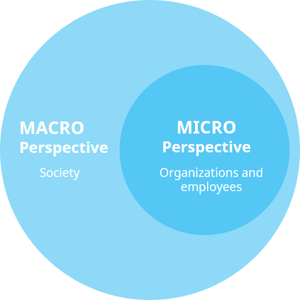The Single Most Important Factor Contributing to Continuing Innovation in American Society is the
The Importance of Innovation – What Does it Mean for Businesses and our Society?
According to McKinsey, 84% of executives say that their future success is dependent on innovation. Although innovation may sound like a buzzword for some, there are many reasons why companies put a lot of emphasis on it. In addition to the fact that innovation allows organizations to stay relevant in the competitive market, it also plays an important role in economic growth. The ability to resolve critical problems depends on new innovations and especially developing countries need it more than ever. We've written quite a few posts about innovation management and this time, we've decided to take a closer look at the reasons that make innovation important for an individual organization and the society at large. Innovation, by definition , is the introduction of something new. Without innovation, there isn't anything new, and without anything new, there will be no progress. If an organization isn't making any progress, it simply cannot stay relevant in the competitive market. Because organizations are often working with other individual organizations, it can sometimes be challenging to understand the impacts of innovation on our society at large. There is, however, a lot more to innovation than just firms looking to achieve competitive advantage. Innovation really is the core reason for modern existence. Although innovation can have some undesirable consequences, change is inevitable and in most cases, innovation creates positive change. We've decided to look at the outcomes of innovation on macro and micro level: Over the last decades, innovation has become a significant way to combat critical social risks and threats. For example, since the Industrial Revolution, energy-driven consumption of fossil fuels has led to a rapid increase in CO 2 emissions, disrupting the global carbon cycle and leading to a planetary warming impact. Our society revolves around continuous economic growth, which mainly depends on population growth. The population is shrinking and ageing in the developed counties and is likely to do so in other parts of the world as well. Innovation is important to the advancement of society as it solves these kinds of social problems and enhances society's capacity to act. It's responsible for resolving collective problems in a sustainable and efficient way, usually with new technology. These new technologies, products and services simultaneously meet a social need and lead to improved capabilities and better use of assets and resources. In order to be able to solve these kinds of societal problems, private, public and non-profit sectors are involved. Because innovation has an impact on so many different parts of our society, it would be almost impossible to go through everything in one post. Therefore, we've decided to focus on the most significant aspects related to the importance of innovation. In general, the result of innovation should always be improvement. From the society's perspective, the fundamental outcomes of innovation are economic growth, increased well-being and communication, educational accessibility and environmental sustainability. Technological innovation is considered as a major source of economic growth. Economic growth refers to the increase in the inflation-adjustedmarket value of the goods and services produced by an economy over time. It is conventionally measured as the percent rate of increase in realgross domestic product, or real GDP. Innovation is responsible for up to 85% of all economic growth. The latter describes the essence of innovation quite well. The purpose of innovation is to come up with new ideas and technologies that increase productivity and generate greater output and value with the same input. According to the aforementioned Stanford study, innovation has been responsible for up to 85% of all economic growth. If we look at the transformation of the US, once a largely agrarian economy that advanced from emerging nation status in the mid-19th century to an industrial economy by the First Wold War, we can see that the agricultural innovations and inventions were actually one of the largest factors that helped bring about the Industrial Revolution. Vast improvements in agricultural productivity had already previously transformed the way people work in Europe, releasing farmers for other activities and allowing them to move to the city for industrial work. The shift from hand-made to machine-made products increased productivity, directly affecting living standards and growth. If previously one worker was able to feed only a fraction of their family, it was now possible for one person to produce more in less time to provide for the entire family. Technological advancement and increased productivity means major changes for careers today as well. The world economy could more than double in size by 2050 due to continued technology-driven product improvements. According to the new World Economic Forum report, nearly 133 million new jobs may be created by 2022 while 75 million jobs are displaced by AI, automation and robotics. Source: World Economic Forum - The Future of Jobs Report 2018 Manual, low-skilled jobs and middle-income roles such as accountants, lawyers and insurance clerks are the ones that will be affected the most over the next decade. The biggest issue here isn't necessarily that these jobs would disappear completely but the fact that polarization of the labor force becomes more significant.New skill sets are required in both old and new occupations. How and where people work will also continue to change. There will be more demand for experts, whereas "regular workers" are at risk of having to settle for low-income positions. In general, innovation and economic growth increases well-being because living standards rise. According to the Brookings Institution, average life satisfaction is higher in countries with greater GDP per capita. Another research also shows that there's a link between innovation and subjective wellbeing. However, not all of the benefits of innovation and growth are evenly distributed. Often, a rise in real GDP means greater income and wealth inequality. Although there isn't a threshold level for how much inequality is too much, greater socioeconomic gaps are most likely have some negative consequences. In theory, income inequality isn't a problem itself except when the concrete purchasing power decreases. In practice, however, it does have a number of impacts on our society and collective well-being. As already mentioned, developing countries depend on innovation as new digital technologies and innovative solutions create huge opportunities to fight sickness, poverty and hunger in the poorest regions of the world. Developed countries also rely on innovation to be able to solve their own problems related to these themes. What comes to reducing hunger, for example, agricultural productivity is critical in the developing countries where the next population boom is most likely to take place. Smallholder farms in developing countries play an important role as up to 80% of the food is produced in these communities. Developing and sharing agricultural innovations such as connecting farmers to information about the weather, has proven to be an efficient way to help farmers stay in business. Although this is just an example of how innovation can help people continue producing food, innovation provides endless other opportunities that can eventually help reduce poverty and hunger around the world. You probably already knew that The World Wide Web celebrates its 30th birthday this year. We've already seen a huge technological revolution during the past decades and continue to do so in the future. According to the World Bank Annual Report 2016, even among the poorest 20 percent of the population, 7 out of 10 households have a mobile phone. This means that more people now have mobile phones than sanitation or clean water. Also, the mobile worker population is expected to grow from around 96 million to more than 105 million by 2020. Innovations in mobile technology such as voice control and augmented reality are enabling workers in completely new ways. Technology innovation can also help rural areas thrive and become more sustainable. Although there are some barriers to technology adoption, such as low income or user capability, more people can access information an improve their knowledge despite their socio-economic position or demographic area. Sustainability and environmental issues, such as climate change, are challenges that require a lot of work and innovative solutions now and in the future. Earth suffers as consumerism spreads and puts consumption at the heart of modern economy. Although consumerism has a positive impact on innovation as a source of economic growth, the rising consumption of innovative products is often considered as one of the reasons for environmental deterioration. Often, politics or other methods aren't enough to make a change – at least not quick enough. Policy changes take time to take effect, which is why the long-term survival of our society and nature depends on new, responsible innovative technologies. Although new greener technology solutions, such as eco vehicles aren't necessarily more competitive alternatives to petrol-powered vehicles just yet, they will definitely offer many advantages for the future. Now that we've looked at the role of innovation from the society's perspective, we can take a closer look at the importance of innovation for organizations and businesses. In general, it's difficult to identify industries where innovation wouldn't be important. Although certain industries depend on innovation more than others, innovation and the ability to improve considers everyone. Even highly regulated industries, such as taxis and banks aren't immune to change. Look what Uber has done to the traditional taxi industry, or how innovation affects financial services. In general, innovation can deliver significant benefits and is one of the critical skills for achieving success in any business. Competitive advantage means the necessary advancements in capabilities that provide an edge in comparison to competitors of the industry. What these are exactly, depends on your business model and the industry you operate in. As already mentioned, for organizations the ability to get ahead of the competition is one of the most significant reasons to innovate. Successful, innovative businesses are able to keep their operations, services and products relevant to their customers' needs and changing market conditions. In fact, according to Deloitte, only 12% of the Fortune 500 companies from 1955 are still in business and half of the S&P 500 companies will be replaced in the next ten years, which is why it's important to be able to quickly respond to external challenges. Innovation increases your chances to react to changes and discover new opportunities. It can also help foster competitive advantage as it allows you to build better products and services for your customers. Increased competitive advantage and continuous innovation often has a direct impact on performance and profitability. According to Global Innovation 1000, there'sa clear difference in both revenue (11%) and EBITDA (22%) growth in favor of the more innovative organizations . These numbers show that innovative companies not only grow faster but are more profitable than the rest. Although measuring the ROI of innovation might be challenging especially in the beginning or when talking about disruptive innovations, investing in innovation is often a surer way to improve your numbers than not innovating at all. Economic growth is driven by innovation and technological improvements, which reduce the costs of production and enable higher output. If we look at this from the perspective of an organization, different automation solutions decrease manual, repetitive work and release time for more important, value-creating tasks. Improved productivity and efficiency makes work more meaningful as less time needs to be spent on low impact tasks. The more time you're able to spend on tasks that have a direct impact on your business, such as improving processes, solving problems or having conversations with your customers, the more likely you're able to actually reduce costs, increase turnover and provide your customers with solutions that truly benefit them. Last but not least, innovation also has a positive impact on company culture as it increases the ability to acquire, create and make the best use of competencies, skills and knowledge. Innovation practices can help build a culture of continuous learning, growth and personal development. This type of innovative environment can again motivate people to constantly improve the way they and their team work. If you look at history, innovation doesn't come just from giving people incentives; it comes from creating environments where their ideas can connect. – Steven Johnson When the entire organization is supportive and provides the right tools for the employees to succeed in their jobs, it eventually has a positive effect on how people perceive their jobs. Generally speaking, the main purpose of innovation is to improve people's lives. When it comes to managing a business, innovation is the key for making any kind of progress. Although your innovation activities aren't necessarily powerful enough to save the world, you should focus on improving the things you can affect. Small improvements eventually lead to bigger and better ideas that may one day become revolutionary. In the meantime, however, you're responsible for finding ways to make improvements in your own sphere of influence. Often, getting started is the hardest part as there are many ways to approach innovation. Our suggestion is to simultaneously work on developing your personal skills and business related aspects. You should, however, start small and pick your focus as it's impossible to achieve everything at once. If you want to start with innovation, we encourage you to try Viima. It's free for unlimited users! This post is a part of our Innovation Management blog-series. In this series, we dive deep into the different areas of innovation management and cover the aspects we think are the most important to understand about innovation management. You can read the rest of the articles in our series covering innovation management by clicking on the button below. Don't forget to subscribe to our blog to receive updates for more of our upcoming content!
Table of contents
What is innovation and why do we need it?
Macro perspective: The role of innovation in our society
The fundamental outcomes of innovation
Economic growth
There's generally two ways to increase the output of the economy:

Innovation and the future of jobs

Increased well-being
Reduced sickness, poverty and hunger

Communication and educational accessibility
Environmental sustainability Micro perspective: The importance of innovation for an organization
Competitive advantage

Maximize ROI
Increased productivity Positive impact on company culture
Conclusion


Source: https://www.viima.com/blog/importance-of-innovation
Post a Comment for "The Single Most Important Factor Contributing to Continuing Innovation in American Society is the"